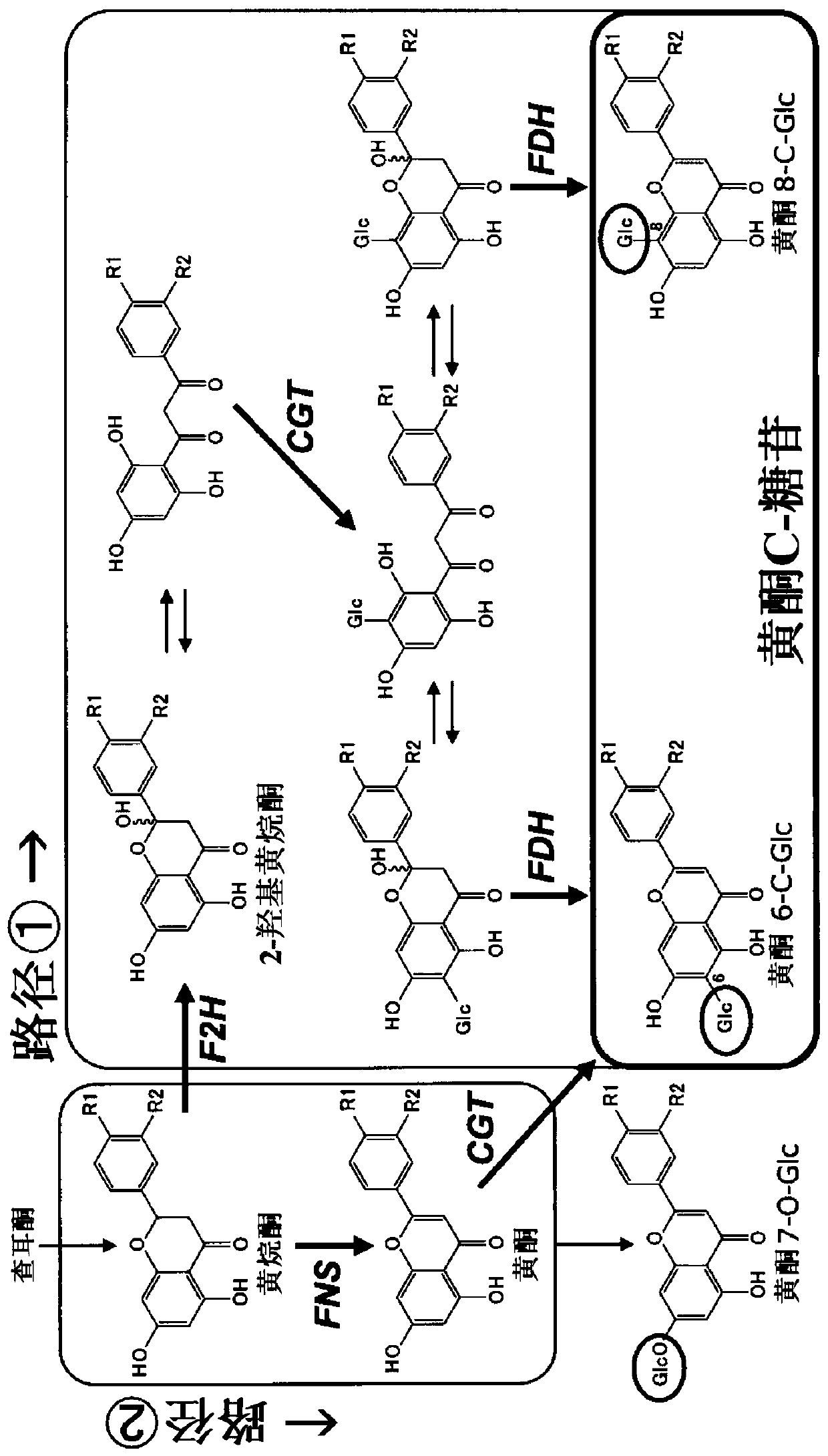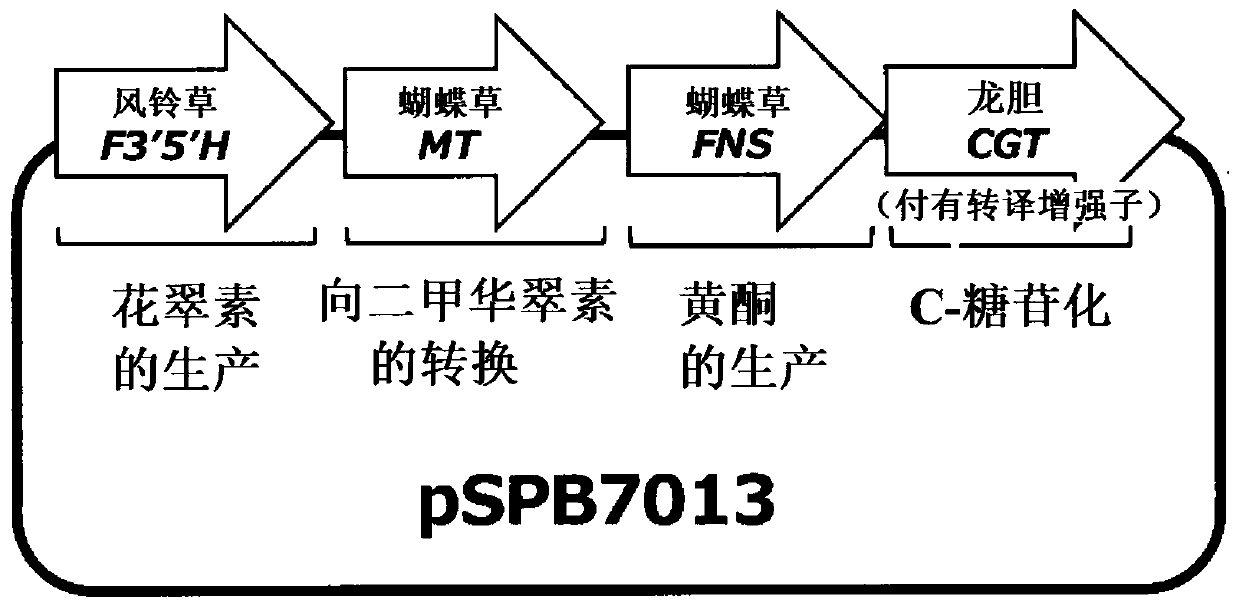Transformed plant having blue flower color, and method for creating same
A plant and gene technology, applied in the field of transformed plants with blue flower colors and its production, can solve the problems of inability to make roses and faded flower colors, etc.
- Summary
- Abstract
- Description
- Claims
- Application Information
AI Technical Summary
Problems solved by technology
Method used
Image
Examples
Embodiment 1
[0292] [Example 1: Simulation of Copigment Effect of Flavonoid C-Glycosides on Anthocyanins]
[0293] In order to simulate the copigment effect of flavone C-glycoside on anthocyanin, anthocyanin and flavone C-glycoside were adjusted. Delphinidin (delphinidin 3,5-diglycoside) and isovitexin (apigenin 6-C-glycoside) used in this experiment were purchased from Funakoshi Corporation.
[0294] With respect to the anthocyanins thus obtained (dimethinin), flavonoid C-glucoside (isovititexin) was added at a molar concentration ratio of 0, 2, and 4 equivalents in a buffer solution of pH 4.5, and the absorption Spectra were measured. The concentration of anthocyanins was set at 0.5 mM.
[0295] The absorbance of anthocyanin aqueous solution was increased by adding flavone C-glucoside, and the absorption extremum (λmax) moved to the long wavelength side with the addition of flavone C-glucoside. From this, it is clear that delphinidin is affected by the copigment effect of isovitexin. ...
Embodiment 2
[0299] [Example 2: (Route 1) Introducing pansy-derived F3'5'H#40 gene, licorice-derived F2H gene, rice-derived CGT gene, and licorice-derived FDH gene into rose variety "Rita Perfumera"]
[0300] pSPB4743 uses pBINPLUS as the basic backbone and contains the following four expression cassettes.
[0301] (1) El 2 35S promoter and F3'5'H full-length cDNA (SEQ ID NO: 1) and D8 terminator from Pansy
[0302] (2) 35S promoter and F2H full-length cDNA (SEQ ID NO: 3) from licorice and AT terminator from perilla
[0303] (3) 35S promoter and CGT full-length cDNA (SEQ ID NO: 5) from rice and AT terminator from perilla
[0304] (4) 35S promoter and FDH full-length cDNA (SEQ ID NO: 7) from licorice and AT terminator from perilla
[0305] The plasmid can constitutively express the F3'5'H#40 gene of pansy, the F2H gene of licorice, the CGT gene of rice and the FDH gene of licorice in plants.
[0306] The thus produced pSPB4743 was introduced into the orange rose variety "Rita·Perfumera"...
Embodiment 3
[0315] [Example 3: (Route 1) Introducing the F3'5'H#40 gene from pansy and the F2H gene from licorice, the CGT gene from rice, and the FDH gene from licorice into the rose variety "noble"]
[0316] The pSPB4743 produced in the same manner as in Example 2 was introduced into the pink rose variety "Noble" to obtain a total of 20 transformants. Pigment analysis was carried out on these, and as a result, accumulation of delphinidin was confirmed in all the individuals, and the delphinidin content rate was the highest at 88% (83.5% on average). Furthermore, in 18 of these individuals, it was confirmed that isovitexin, which is a flavonoid C-glycoside, was produced in the highest amount of 0.06 mg per 1 g of the fresh weight of petals.
[0317] The analytical values of representative transformants are shown in Table 3 below.
[0318] [table 3]
[0319]
[0320] Host: Noble
PUM
 Login to View More
Login to View More Abstract
Description
Claims
Application Information
 Login to View More
Login to View More - R&D
- Intellectual Property
- Life Sciences
- Materials
- Tech Scout
- Unparalleled Data Quality
- Higher Quality Content
- 60% Fewer Hallucinations
Browse by: Latest US Patents, China's latest patents, Technical Efficacy Thesaurus, Application Domain, Technology Topic, Popular Technical Reports.
© 2025 PatSnap. All rights reserved.Legal|Privacy policy|Modern Slavery Act Transparency Statement|Sitemap|About US| Contact US: help@patsnap.com



